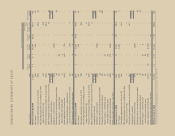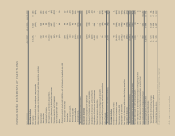Sara Lee 2011 Annual Report Download - page 78
Download and view the complete annual report
Please find page 78 of the 2011 Sara Lee annual report below. You can navigate through the pages in the report by either clicking on the pages listed below, or by using the keyword search tool below to find specific information within the annual report.
FINANCIAL REVIEW
not reasonably likely to have a material impact on future operating
results. However, changes in estimates and assumptions related
to previously issued performance based RSUs may have a material
impact on future operating results.
Defined Benefit Pension Plans See Note 16 to the Consolidated
Financial Statements, titled “Defined Benefit Pension Plans,” for
information regarding plan obligations, plan assets and the meas-
urements of these amounts, as well as the net periodic benefit
cost and the reasons for changes in this cost.
Pension costs and obligations are dependent on assumptions
used in calculating such amounts. These assumptions include
estimates of the present value of projected future pension payments
to all plan participants, taking into consideration the likelihood of
potential future events such as salary increases and demographic
experience. The assumptions used in developing the required esti-
mates include the following key factors: discount rates, salary growth,
expected return on plan assets, retirement rates and mortality.
In determining the discount rate, the corporation utilizes a yield
curve based on high-quality fixed-income investments that have a AA
bond rating to discount the expected future benefit payments to plan
participants. Salary increase assumptions are based on historical
experience and anticipated future management actions. In deter-
mining the long-term rate of return on plan assets, the corporation
assumes that the historical long-term compound growth rate of equity
and fixed-income securities will predict the future returns of similar
investments in the plan portfolio. Investment management and other
fees paid out of plan assets are factored into the determination of
asset return assumptions. Retirement rates are based primarily on
actual plan experience, while standard actuarial tables are used to
estimate mortality. Results that differ from these assumptions are
accumulated and amortized over future periods and, therefore,
generally affect the net periodic benefit cost in future periods.
Net periodic benefit costs for the corporation’s defined benefit
pension plans related to continuing operations were $36 million
in 2011, $99 million in 2010 and $59 million in 2009, and the pro-
jected benefit obligation was $4.483 billion at the end of 2011 and
$4.335 billion at the end of 2010. The corporation currently expects
its net periodic benefit cost for 2012 to be approximately $8 million
of income. The year-over-year change versus 2011 is due primarily
to an increase in expected return on assets due to higher plan assets
at the end of 2011 as compared to the prior year and a reduction
in the amortization related to actuarial gains/losses as a result of
actuarial gains during 2011 which reduced the amount of unamor-
tized actuarial losses to be amortized.
• Facts and circumstances may change that cause the corporation
to revise the conclusions on its ability to realize certain net operating
losses and other deferred tax attributes. The corporation regularly
reviews whether it will realize its deferred tax assets. Its review
consists of determining whether sufficient taxable income of the
appropriate character exists within the carryback and carryforward
period available under respective tax statutes. The corporation
considers all available evidence of recoverability when evaluating
its deferred tax assets; however, the corporation’s most sensitive
and critical factor in determining recoverability of deferred tax assets
is the existence of historical and projected profitability in a particu-
lar jurisdiction. As a result, changes in actual and projected results
of the corporation’s various legal entities can create variability, as
well as changes in the level of the corporation’s gross deferred tax
assets, which could result in increases or decreases in the corpo-
ration’s deferred tax asset valuation allowance.
As a multinational company, the corporation cannot predict with
reasonable certainty or likelihood future results considering the
complexity and sensitivity of the assumptions above.
Note 18 to the Consolidated Financial Statements, titled “Income
Taxes,” sets out the factors which caused the corporation’s effective
tax rate to vary from the statutory rate and certain of these factors
result from finalization of tax audits and review and changes in esti-
mates and assumptions regarding tax obligations and benefits.
Stock Compensation The corporation issues restricted stock units
(RSUs) and stock options to employees in exchange for employee
services. See Note 9 to the Consolidated Financial Statements
regarding stock-based compensation for further information on
these awards. The cost of RSUs and stock option awards is equal
to the fair value of the award at the date of grant, and compensation
expense is recognized for those awards earned over the service
period. Certain of the RSUs vest based upon the employee achieving
certain defined performance measures. During the service period,
management estimates the number of awards that will meet the
defined performance measures. With regard to stock options, at
the date of grant, the corporation determines the fair value of the
award using the Black-Scholes option pricing formula. Management
estimates the period of time the employee will hold the option prior
to exercise and the expected volatility of the corporation’s stock, each
of which impacts the fair value of the stock options. The corporation
believes that changes in the estimates and assumptions associated
with prior non-performance based grants and stock option grants are
























